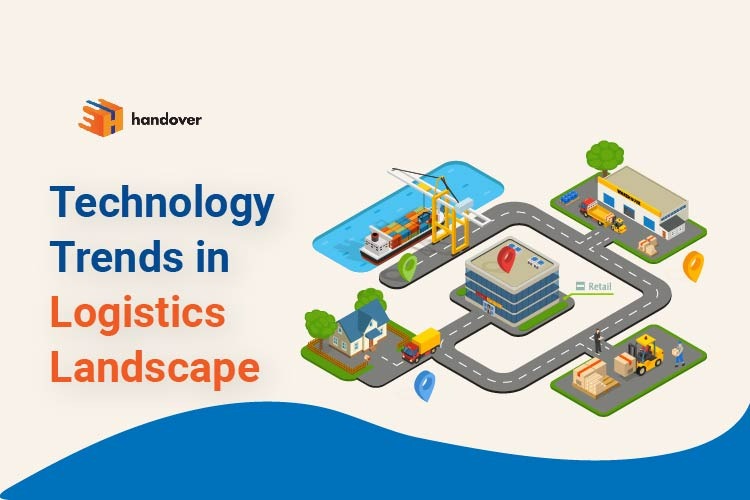Handover news
Blog
Technology Trends in Logistics Landscape

The logistics industry is moving at a great pace amid technological advancements. This industry stands to gain a great deal from innovation and cutting-edge trends in logistics technology because of its manual procedures and different data sources that take lots of labour while technologies have tremendously reduced the hard labour.
The logistics sector has entered a new phase of innovation in recent years with the help of automation, enhanced analytics, and artificial intelligence. Startups contribute to this momentum by showcasing their innovative solutions. But along with opportunity, these developments also raise expectations. Logistics companies have a dilemma: either they change or they will disappear as more and more people and enterprises require quick and low-cost delivery solutions. This tough competition between companies forced them to use technology because customers prefer their orders to come fast. In this blog, we will write about the latest technological trends in the logistics industry.
These are the Technology Trends in the Logistics Industry
Cloud Logistics
The future of logistics is in remote-hosted data and processes, so about half of the logistics companies are embracing cloud-based services. Cloud services, which provide flexibility and instant access to vital analytics and operations software, are making it possible to scale highly responsive pay-per-use and on-demand business models, which are increasingly common in the logistics industry.
Cloud logistics are becoming more and more appealing because of the time and cost advantages.
Internet of Things
The Internet of Things’ (IoT) connectivity has the potential to increase operational security, optimise usages, and improve operational efficiency in addition to lowering costs.
Supply chains can function as self-monitoring and self-maintaining systems thanks to the continuous data exchange between devices and logistical providers. Smart sensors in warehouse environments will notify robots when orders need to be picked and packed or restocked, and onboard telematics will optimise delivery routes in vehicles. These developments will drastically change logistics operations both now and in the near future.
Blockchain
The logistics sector could see a radical transformation because of decentralised ledger technology. Blockchains can eliminate paperwork from invoices, minimise delays, prevent fraud, and save money across supply chains by eliminating several layers of complexity through transparent and safe transactional relationships.
For now, blockchain technology needs to overcome the stigma associated with dubious cryptocurrencies and demonstrate its scalability. However, if we look at the future, the secure interconnection that blockchain offers might significantly speed up payments and boost transparency in a sector that can be stressful due to its bureaucratic intricacy.
Artificial Intelligence
Smart devices that provide increasingly insightful, digital services will be the hallmark of the future.
Logistics procedures can be streamlined to incredibly high levels of efficiency by managing back-office responsibilities like accounting and human resources, as well as enhancing human abilities like in the warehouse.
AI-led automation, fed by data harvested from IoT systems, can be used as a predictive tool in processes like warehousing, where it can anticipate changes in demand and avert shortages or overstocking. Using robotic systems, computer vision and assistance bots can automate mechanical tasks and improve consumer experiences. AI-powered demand analysis has the potential to boost retail and marketing tactics.
Big Data Analytics
The flood of data produced by supply chains is the foundation for network enhancements and structural adjustments.
By analysing this stream of data, a new way of revenue generation for individual supply chain links can be identified, as well as insights that will help optimise processes like capacity utilisation and forecast and lower the costs of risks.
These insights can also be predictive, allowing for proactive inventory adjustments to avoid storing excess inventory and to move goods closer to the markets at the right time.
Robotics and Automation
A lot of warehouses are operated manually, leading to suboptimal stocking and increased delivery delays. Automation is the answer to resolve these concerns.
Some logistics companies have, however, started using robotics and automation to reduce repetitive tasks. Future robotics will only become more advanced, improving last-mile delivery services. AI-powered trailer-loading bots will free humans from this physically demanding job and load vehicles in the most efficient manner possible.
Conclusion
Advanced technologies in the logistics industry help enhance work efficiency. And every day technologies are becoming better to serve the logistics industry. This trend in technology has been helping the logistics industry operate effectively and meet customers’ expectations. If you want to get help from these technologies, you can collaborate with handover, a logistics services company in India, which helps businesses with on-time and reliable delivery services in Ghaziabad, Noida, Delhi, Mumbai, Bangalore, Pune and several other places across India.
